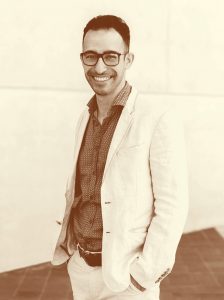For people who spend a lot of time outdoors, skin cancer is a workplace risk associated with the job. One engineer hopes to provide early warning of when they’re in danger.
When Dr Reza Behi arrived in Australia from Europe in 2015 to begin a biomedical engineering PhD, he noticed the side-effects of the famously sunburnt country.

“I’d been working in the space of cancer diagnosis and living in Australia, seeing colleagues and even close friends who’ve had the same issue [skin cancer], and going through the fundamentals of this work, realising there’s not such a proactive solution,” he told create.
“I came up with this idea and developed a tiny device the size of a one-dollar coin that could be integrated into personal protective equipment, monitor UV exposure and let [workers] know when they need to renew sunscreen protection or where they are getting to a dangerous limit of exposure.”
Behi took to the unsolved problem towards the end of his doctorate, juggling cancer detection research through nanobiosensors with a crash course in entrepreneurialism. He founded his company Metasense to address workplace environment monitoring.
According to the Australian Institute of Health and Welfare, Australia is among the world leaders in skin cancer rates, with about 13,280 melanoma diagnoses in 2016 and roughly 1770 deaths. Ninety-six per cent of melanomas — one of the most dangerous types of skin cancer — were due to UV exposure and two-thirds of Australians will get a skin cancer diagnosis by age 70.
Federal authority the Australian Radiation Protection and Nuclear Safety Agency offers guidelines for safe doses of UV, based on factors such as time, intensity — gauged by the UV index — and skin type (through the Fitzpatrick skin phototype, with six groupings from pale white to deeply pigmented skin).
“We take it into account, monitoring those exposures in real time, and then if they hit or are close to that threshold, just get a reminder to them that they’re already close to that limit and they need to take the right action,” explained Behi of Metasense’s system.
The technology uses a small sensor and communications package called SafeSpot, which measures environmental factors including location, UV, humidity and temperature, and which integrates into PPE such as hard hats. Metasense’s system also features software and an app.
Later additions to the company’s products have included a camera for worksites to produce high-definition images of eyes and skin to share with ophthalmologists and dermatologists, as well as physical distancing monitoring.
“Based on exposure, there will be a regular inspection of the eye,” Behi said.
“And if they observe anything unusual on their skin, then there can be a high-resolution image that is forwarded to a specialist for a quick review.”
It has customers in transport, agriculture, mining and construction, and a trial with John Holland was conducted earlier this year.
Metasense’s successes in 2020 included making the final 12 of the St George Kick Start program for start-ups.
Behi believes that his shift from research work to starting a company presented a steep learning curve, but there have been similarities between the two.
“That’s been quite challenging… to get the technology to work at a level that can be presented in a product to the customer. And then at the same time, trying to work on the business side to validate the product,” he said.
“But I think there is a pretty similar methodology with research. You need to do a bit of a literature review, studying what’s being done, what’s the gap, and proposing a solution. And in business it’s the same: you’re seeing the problem; you validate the problem and create a solution to that problem.”
Seeing results
Behi finished his PhD at the University of Sydney in 2018, adding to an earlier professional doctorate in engineering from Eindhoven University of Technology in Holland. His work took in energy storage and nanoscale energy transfer before he shifted to medical-focused research.
Behi’s PhD examined nanobiosensor arrays and associated devices able to rapidly detect various cancers at the point of care.
The technology patented by Behi uses a nanoarray of gold nanoparticles and quantum dots, which are bridged by peptides.
These peptides — which can be substituted for others to detect different cancers — dissolve when exposed to small amounts of matrilysin, a biomarker produced by saliva glands and associated with colorectal cancer. The released gold nanoparticles produce an optical signal.
Behi said this printable biosensor work has gained the interest of several venture capitalists.